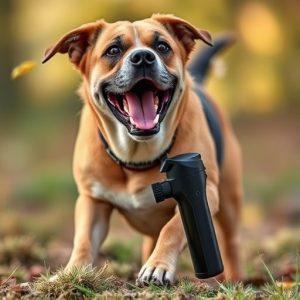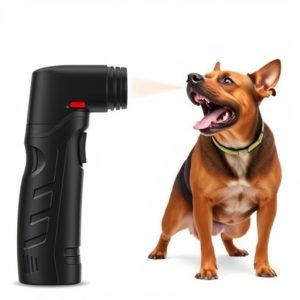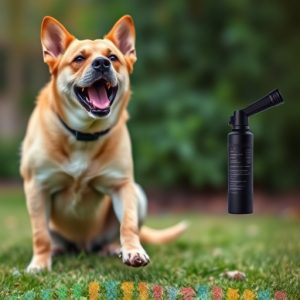Safe Dog Attack Spray: Science, Choice, Application & Legalities
Dog attack spray, utilizing capsaicin, offers non-lethal self-defense against aggressive canines. Ef…….
Dog attack spray, utilizing capsaicin, offers non-lethal self-defense against aggressive canines. Effective formulations range from 2% to 5% capsaicin, temporarily disorienting dogs with eye and respiratory irritation. Choosing the right spray involves considering specific dog breed effectiveness, safe strengths (10%-20%), range, accuracy, and brand safety guidelines. Proper usage training emphasizes aiming for eyes and face at a distance, creating a disorienting cloud. Balancing potency and safety ensures minimal harm while adhering to local regulations on dog deterrence methods.
“Staying safe during encounters with aggressive dogs is paramount, and dog attack spray emerges as a powerful tool. This comprehensive guide explores the ‘Quick Release’ variant, offering an effective yet controlled response. We delve into the science behind pepper spray’s efficacy against dogs, emphasizing its role in personal protection.
Learn about critical factors when choosing safe pepper spray with suitable strength for dogs, explore application techniques, and understand legal considerations to ensure responsible usage.”
- Understanding Dog Attack Spray: A Comprehensive Overview
- The Science Behind Pepper Spray and Its Efficacy Against Dogs
- Choosing the Right Safe Pepper Spray for Dogs: Factors to Consider
- Application Techniques: How to Use Quick-Release Dog Attack Spray Effectively
- Legal Implications and Safety Precautions: Responsible Use of Pepper Spray on Dogs
Understanding Dog Attack Spray: A Comprehensive Overview
Dog attack spray, also known as pepper spray for dogs, is a non-lethal self-defense tool designed to temporarily incapacitate an aggressive canine. Understanding its functionality and effectiveness is crucial when considering its use. This type of spray contains capsaicin, the same compound found in hot peppers, which irritates the dog’s eyes, nose, and throat, leading to temporary disorientation and a retreat from the perceived threat.
Choosing the right dog attack spray involves considering factors like safe pepper spray strength specifically tailored for dogs. Products vary in concentration, with lower strengths being safer for both pets and users while still providing adequate protection. It’s important to follow manufacturer guidelines and local regulations regarding the acquisition and use of such sprays. Proper training on how and when to deploy the spray is equally vital to ensure its effectiveness and minimize potential harm during a dog attack.
The Science Behind Pepper Spray and Its Efficacy Against Dogs
The Science Behind Pepper Spray and Its Efficacy Against Dogs
Pepper spray, a potent irritant derived from chili peppers, has become a popular self-defense tool for individuals facing aggressive dog encounters. The active ingredient in pepper spray is capsaicin, which is responsible for the burning sensation it causes when it comes into contact with mucous membranes and skin. In terms of safe pepper spray strength for dogs, studies have shown that concentrated formulations (typically around 2% to 5%) are effective in neutralizing dog aggression temporarily.
When a dog is sprayed in the face or eyes, capsaicin disrupts sensory nerve signals, leading to temporary blindness, sneezing, and excessive drooling. This disruption can help an individual gain time to escape or defend themselves. However, it’s crucial to note that pepper spray should be used as a last resort, as it may not always be effective on all dogs—especially larger breeds or those with aggressive training. Moreover, the safety and effectiveness of pepper spray depend on proper usage techniques and understanding the unique circumstances of each dog-human interaction.
Choosing the Right Safe Pepper Spray for Dogs: Factors to Consider
When selecting a safe pepper spray for dog attacks, understanding your specific needs and local regulations is key. Look for products designed explicitly for canine deterrence, as they often come with features tailored to animal usage, like non-lethal formulations and quick-release mechanisms.
Consider factors such as strength—measured in capsaicin units (CU) per spray—suitable for dogs without causing severe harm. A higher CU count may be required for larger breeds or aggressive dogs. Additionally, check the range and accuracy of the spray, ensuring it can reach and deter an attacking dog effectively. Always opt for a brand that prioritizes safety, offering instructions clear to both users and pets.
Application Techniques: How to Use Quick-Release Dog Attack Spray Effectively
When using a dog attack spray, understanding the application technique is key to its effectiveness. For optimal results, aim for the eyes and face—these areas are highly sensitive and can quickly disable an attacker. Hold the canister at a safe distance (typically 3-4 feet) and swing it in an arc towards your target, releasing the trigger when the dog comes into range. The spray should create a cloud that envelops the animal, temporarily blinding and disorienting it, giving you precious time to escape or gain control.
Choosing the right safe pepper spray strength for dogs is crucial. Look for canisters with a high concentration of capsaicin, the active ingredient responsible for the burning sensation. A strength of 10% to 20% capsaicin is generally recommended for dog attack sprays, striking a balance between potency and safety. Always follow the manufacturer’s instructions and guidelines for safe use, including ensuring proper ventilation and avoiding contact with eyes or sensitive areas. Regularly test the spray and replace it as needed to guarantee its effectiveness when you need it most.
Legal Implications and Safety Precautions: Responsible Use of Pepper Spray on Dogs
When considering the legal implications and safety precautions surrounding the responsible use of pepper spray on dogs, it’s crucial to understand that not all pepper sprays are created equal. The safe pepper spray strength for dogs should be carefully evaluated, with a focus on minimizing harm while ensuring effectiveness. Using excessive force or inappropriate products can lead to legal consequences and potential animal cruelty charges.
Dog owners and handlers must familiarize themselves with local laws and regulations regarding the use of pepper spray on animals. Proper training is essential to ensure that the spray is deployed accurately and safely, aiming for non-lethal means while still neutralizing the threat. Always opt for dog-specific formulations designed with a gentle yet powerful enough formula to deter aggressive behavior without causing severe harm or long-term health issues.
Dog attack spray, particularly quick-release varieties, can be a powerful tool for self-defense against aggressive dogs. By understanding its science, choosing the right safe pepper spray with adequate strength for dogs, and learning proper application techniques, individuals can effectively protect themselves and their loved ones. However, it’s crucial to navigate legal implications and adhere to safety precautions when using such sprays responsibly.


